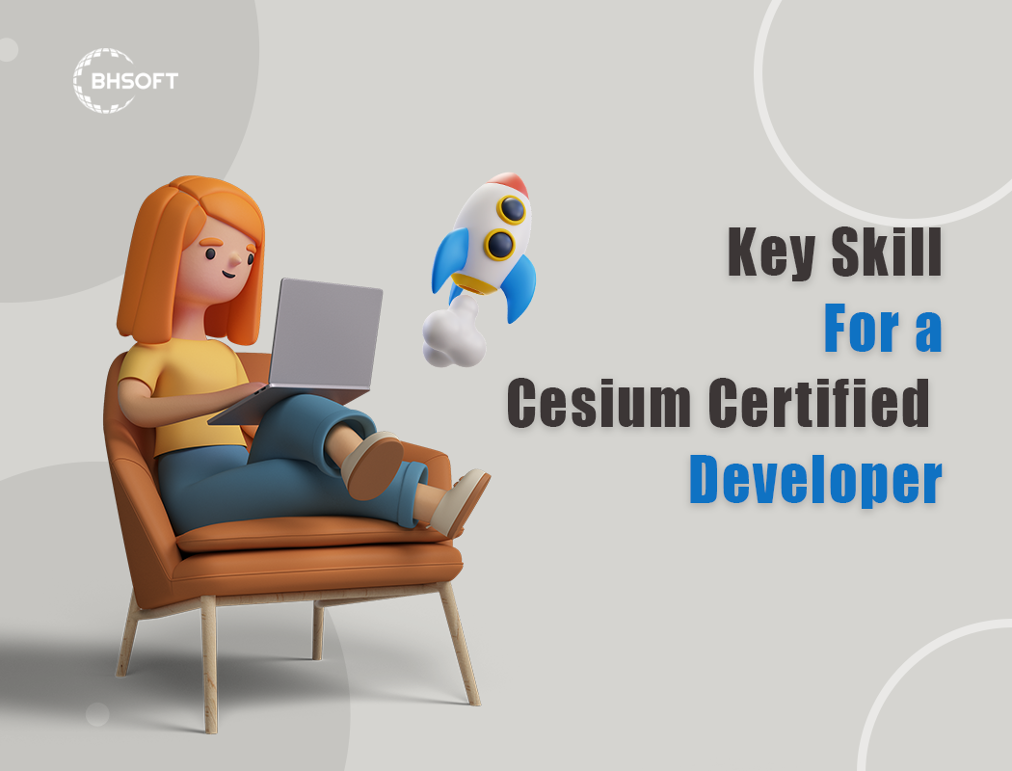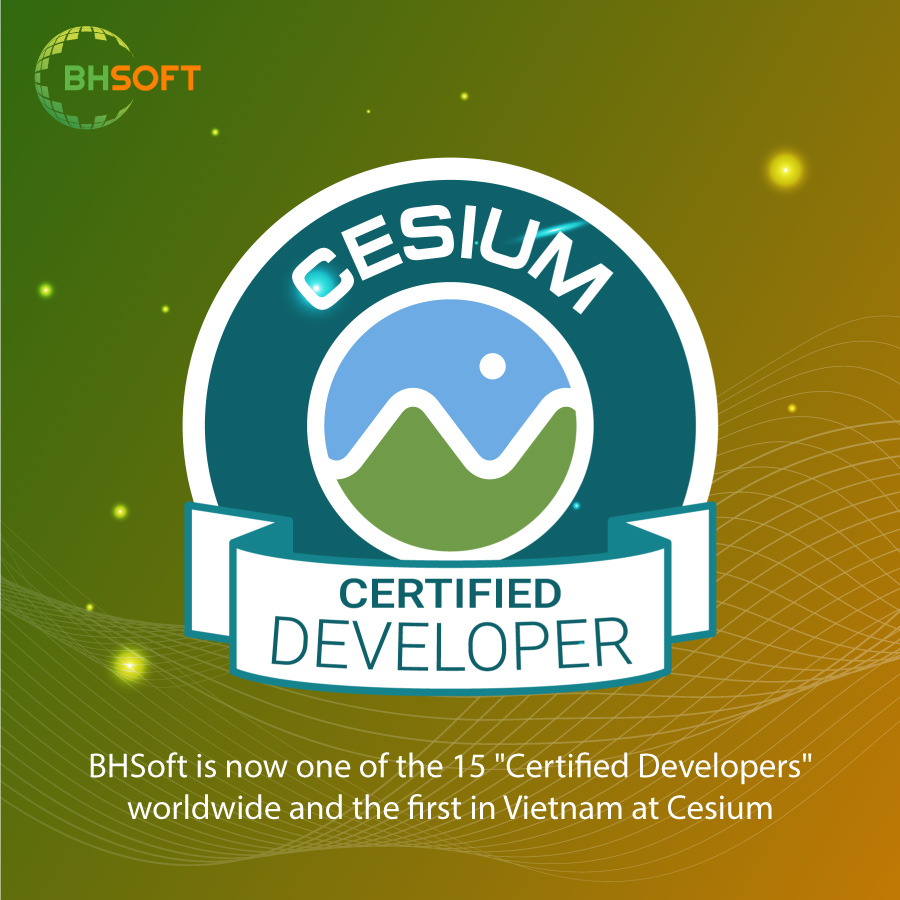Home > Insights > IT Business
Key Skills for a Cesium Certified Developer
5 minutes read
Audio description available
Jun 29, 2023
The rise of 4.0 technology has led to a growing demand for interactive and immersive mapping experiences. This demand has created a need for skilled Cesium developers who can effectively utilize Cesium, the primary technology behind these experiences. This article will look at the skills needed to become a Cesium Certified Developer, highlighting the knowledge and abilities that set competent developers apart in this fast-paced field.

CesiumJS Definition
CesiumJS is a JavaScript library that allows developers to create stunning 3D web applications. It focuses on geospatial data and allows users to interact with maps, terrain, and imagery in a 3D environment. CesiumJS utilizes WebGL, a technology for rendering 3D graphics in web browsers, to ensure high performance and visually appealing experiences.
Developers can use CesiumJS to create various applications, such as virtual globes, flight simulators, and urban planning tools. It offers features to handle geospatial data, supporting different data formats, coordinate systems, and map projections. In addition, the library includes APIs for controlling the camera, applying custom visual effects, accessing external data, and responding to user input.
CesiumJS is well-known for its adaptability and compatibility with popular JavaScript frameworks such as React and Angular. It is constantly updated and improved by a dedicated developer community. It also offers extensions and plugins for enhancing its features and capabilities.

Essential Skills for Cesium Certified Developer
For developers who want to work with Cesium, having a suitable skill set is critical. Here are the top skills that every Cesium developer should master to excel in this field:
Proficiency in JavaScript
To become a successful Cesium Certified Developer, it is important to have a strong foundation in JavaScript. JavaScript serves as the main programming language for building applications with Cesium, and having a solid understanding of its core concepts and syntax is crucial. Proficiency in JavaScript enables developers to fully utilize the capabilities of Cesium and create engaging 3D geospatial applications.
Having a good grasp of fundamental JavaScript features like variables, functions, loops, and object-oriented programming principles is essential. This allows developers to effectively manipulate data and control the behavior of their Cesium applications. Additionally, staying updated with the latest JavaScript frameworks and libraries, such as React and Angular, is advantageous, as they seamlessly integrate with Cesium and enhance developer productivity.
By mastering JavaScript and staying abreast of the evolving JavaScript ecosystem, aspiring Cesium developers can confidently embark on their journey to become Cesium Certified Developers. This solid foundation will provide the necessary skills to unlock the full potential of Cesium and create compelling and interactive 3D geospatial applications.
Geospatial Knowledge
To become a Cesium Certified Developer, it's important to understand geospatial concepts and technologies. This includes being familiar with Geographic Information Systems (GIS), coordinate systems, and spatial data formats like GeoJSON and Shapefile. Knowledge of geospatial data visualization techniques and cartographic principles is also valuable.
Cesium developers need to work with real-world geographical data and convert it into interactive visual representations using the Cesium framework. Understanding projections, map projections, and geodetic calculations is crucial for accurate geospatial rendering.

Cesium API and Library
Another requirement is a thorough understanding of the Cesium library and its Application Programming Interface (API). Developers must be familiar with Cesium's core classes, such as Scene, Camera, and Entity, and understand how to use them to create and manipulate 3D objects and terrains.
Developers who are familiar with Cesium's API can control the camera's behavior, manage user interactions, and implement advanced features such as terrain analysis and dynamic data visualization. Understanding the lifecycle of Cesium components and managing resources efficiently are also critical for optimizing the performance of Cesium-based applications.
Developers should also be familiar with the Cesium API's available methods, properties, and events. This allows them to control the rendering pipeline, handle user input, and respond to various events and interactions within their applications. Additionally, understanding how to efficiently load and unload resources, such as 3D models, terrain data, and imagery, is crucial for maintaining optimal performance and minimizing memory usage.
By gaining a deep understanding of the Cesium library and its API, developers can harness the full potential of Cesium and build robust and feature-rich 3D geospatial applications. This skill enables them to create immersive experiences, precisely manipulate 3D objects and terrains, and optimize the performance of their applications for a seamless user experience.
3D Graphics and Visualization
An important skill for a Cesium Certified Developer is creating visually appealing and interactive 3D graphics. This requires a good understanding of computer graphics concepts such as rendering pipelines, shaders, and lighting models. Proficiency in WebGL, the technology that powers Cesium, is essential for efficiently manipulating and rendering 3D graphics.
Furthermore, developers should have knowledge of 3D modeling and asset optimization techniques. This allows them to create optimized and visually stunning models for Cesium applications. Understanding concepts like texture mapping, normal mapping, and mesh optimization contributes to delivering a seamless and immersive user experience.
Problem-Solving and Debugging Skills
As with any software development role, problem-solving and debugging skills are essential for a Cesium Certified Developer. Troubleshooting complex issues, identifying performance bottlenecks, and resolving compatibility problems are common challenges in developing Cesium applications.
Proficient developers should be able to analyze and debug code effectively, using tools like browser developer consoles and Cesium's built-in debugging features. They should possess the ability to break down complex problems into manageable parts and find innovative solutions while adhering to best practices.
Conclusion
To summarize, becoming a Cesium Certified Developer requires a combination of technical expertise and practical experience in geospatial development. The key skills mentioned above, such as strong JavaScript proficiency, geospatial knowledge, mastery of the Cesium library and API, 3D graphics skills, and effective problem-solving abilities, are essential for a competent Cesium developer. By honing these skills, aspiring developers can unlock the full potential of Cesium's capabilities and create innovative and immersive 3D geospatial applications that push the boundaries of web-based mapping technology.
BHSoft is a top software development company based in Vietnam that specializes in providing exceptional Cesium and other

